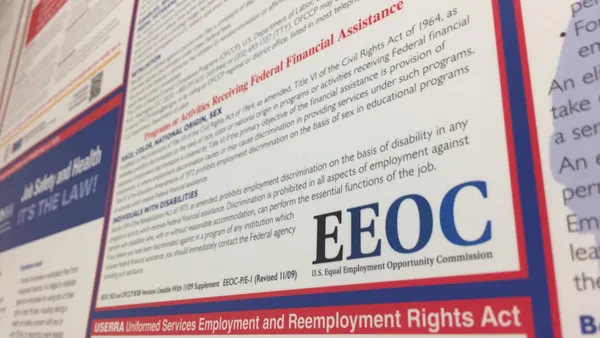Dive Brief:
- The U.S. Supreme Court should decide whether exposure to a single racial slur can support a hostile work environment claim, a former hospital employee argued in a Jan. 25 petition.
- The plaintiff asked the high court to revisit a 5th U.S. Circuit Court of Appeals opinion issued last year that allegedly continued a circuit split on the issue.
- The 5th Circuit determined in Collier v. Dallas County Hospital District, dba Parkland Health & Hospital System (No. 19-10761 (Sept. 30, 2020)) that an employer did not create a working environment "sufficiently abusive to constitute a hostile work environment" when it allowed a slur to remain on an elevator for months, despite the plaintiff’s complaints.
Dive Insight:
Title VII of the Civil Rights Act of 1964 prohibits race discrimination in employment. Harassment can amount to discrimination, and can be actionable when, among other circumstances, an employer fails to address the harassment.
According to the 5th Circuit’s opinion, some courts have found that offensive graffiti that remains for a prolonged period of time, especially once it has been reported, can support such a bias claim. The 8th Circuit, for example, in 2010 drew a distinction between spoken and written slurs. "[T]he key difference between graffiti and a racial slur should not be overlooked: the slur is heard once and vanishes in an instant, while graffiti remains visible until the employer acts to remove it," the Collier court said, quoting Watson v. CEVA Logistics U.S., Inc., 619 F.3d 936, 943 (8th Cir. 2010).
The 5th Circuit also pointed out that other courts have taken a hard-line stance on the particular slur used in Collier, deeming it so offensive that even one verbal incident can create a hostile work environment claim.
Still, the 5th Circuit found that the incident in question was insufficient to show such bias, citing its own precedent. "In fact, [the plaintiff] admitted that the graffiti interfered with his work performance by only one percent. Moreover, [he] does not argue that he felt humiliated by the graffiti, nor would the record support such an assertion," it said. "Accordingly, on the record before us, [his] hostile-work-environment claim fails because it was not ‘sufficiently severe or pervasive to alter the conditions of the victim’s employment and create an abusive working environment.’"
Employers aiming to avoid such claims should conduct employee training, with separate sessions for managers, experts previously told HR Dive. HR also can set clear policies prohibiting harassment and devise a reporting mechanism for complaints, they suggested. When it receives such a complaint, employment attorneys previously said HR should conduct a good-faith investigation and, if it finds misconduct, take action to prevent it from recurring.











